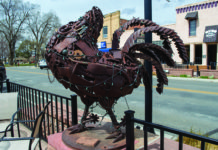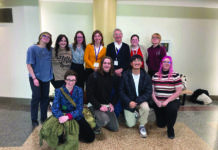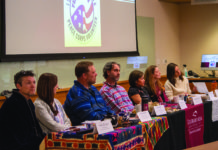The second annual History Week at Colorado Mesa University brought with it six presentations this year — one on each day of the week, with two on Thursday. History Week’s purpose is to shine light upon the path a historian can take, according to Phi Alpha Theta President Jeff Baker.
“Some people don’t realize what our history professors are doing in their off time, some of the great impacts they’re making in the area,” Baker said.
For example, Dr. John Seebach gave the last presentation of the week on Friday evening. The difference there was that Seebach is not a history instructor at CMU like the other five presenters. He’s an assistant professor of archaeology.
Dr. Seebach’s presentation was still historical, however, as he used archaeological discoveries to clear up misconceptions of Paleoindians, as well as to give insight to a historical location in Grand Junction: the Teller Indian School.
In his lecture, Seebach said that the assumptions that the Paleoindians only ever hunted while doing little of anything else were false.
“What we can say is that people did slow down, have campsites, chill out and express themselves creatively,” Seebach said, showing PowerPoint slides of historic artwork believed to be dated back to the time of the Paleoindians. He spoke of determining which art was questionable, which was positively authentic, and which was known to be fraudulent.
Seebach then turned the presentation to the opening of the Teller Indian School and said that many people don’t realize the historic facility was ever here.
According to Seebach, these schools’ purpose was to train Indians to be civilized, for, at that time, every race was placed on a scale called “The Ladder of Cultural Evolution,” devised by Lewis H. Morgan and consisting of the categories “Savagery,” “Barbarism” and “Civilization.”
During a lottery to determine the location of an Indian School out west, Senator Henry M. Teller of Grand Junction fought for having it in Grand Junction and won. The first building of the Teller Indian School was built in 1886.
“The main point was to lead, basically, a culture removal and replacement institution,” Seebach said.
 Seebach showed a record of deaths at the school and said that the school’s cemetery had been lost when the school had been shut down, ravaged and stripped.
Seebach showed a record of deaths at the school and said that the school’s cemetery had been lost when the school had been shut down, ravaged and stripped.
“All of the headstones were removed at one time, and we have no idea where that cemetery is to this day,” Seebach said. “That’s how I got involved in this whole thing because I’m part of this preservation attempt and one thing we’re attempting above all other things is to find the cemetery, fence it, and memorialize what happened here.”
The audience asked questions following Dr. Seebach’s presentation, asking where the information proving the existence of the lost cemetery came from. Seebach answered that they mostly came from old articles in The Daily Sentinel that reported deaths there, as well as other documentation of the cemetery itself.
At some point in a Sentinel article, it was said that members of the school walked down to the cemetery, proving that it is close by the site of the school. Today, the remains of the old school are the Grand Junction Regional Center, a mental health facility, and the records from the school itself were lost in a fire, according to Seebach.
Now, the federal government has gone back on their original deal to leave the Teller Indian School alone. Due to a bill signed by Governor John Hickenlooper, according to Seebach, the property is now being sold. Between the time that it sells and the time that its purchase by another party, Seebach wants to find the cemetery.
“In April, I’ll have a team of cadaver dogs out for a very brief test,” Seebach said. “I hope to be out there to see if we can take some test units and see if we can find some of these old buildings and see if we can preserve some of this history.”






